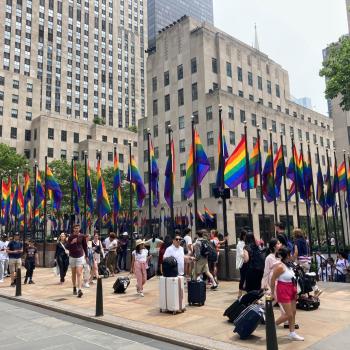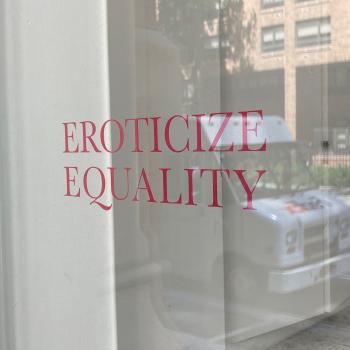“The Pope said something about gay.”
*cue media firestorm*
As the author of Ecclesiastes reminds us, “there’s nothing new under the sun.”
We were reminded once again today of what the Church proclaimed in the 1986 “Halloween Letter”: that the Catholic Church affirms the dignity of all people, no matter how their erotic desire happens to manifest, and that we are called to orient our sexuality toward God, in a manner that conforms to his creative design. While the Popes since then may have accented different aspects of that teaching, things haven’t changed that much.
Aside from a few more nuanced responses from the likes of Eve Tushnet and Chris Damian, doctrinally-assenting Catholics cheered on Pope Francis for approving the CDF’s reiteration that same sex relationships don’t constitute a marriage (nor do civil unions), and dissenting Catholics bemoaned his lack of willingness to really affirm the LGBT community.
While I acknowledge Tushnet and Damian’s assertion that the Church ought to move from a position of telling people what they can’t do and toward what they can do, I think it’s worth looking at why this dichotomy between religion and homosexuality exists in the first place.
At the root of this back-and-forth about whether being gay is “ok” or not is a matter that transcends ethics. What’s at hand here is the friction between two metaphysical worldviews, or two “social imaginaries” as Charles Taylor would put it.
Taylor says of the distinction between the pre and post-Enlightenment modes of conceiving of the self and one’s actions:
One of the big differences between us and our ancestors of five hundred years ago is that they lived in an “enchanted” world, and we do not; at the very least, we live in a much less “enchanted” world…The enchanted world was one in which these forces could cross a porous boundary and shape our lives, psychic and physical. One of the big differences between us and them is that we live with a much firmer sense of the boundary between self and other. We are “buffered” selves…Modern Westerners have a clear boundary between mind and world, even mind and body. Moral and other meanings are “in the mind.”
The social imaginary of most young people growing up in developed Western cultures is informed by the idea that one’s actions and choices are an expression of one’s true identity. Some are on team Pepsi, others team Coke. Some are Beliebers, others are Little Monsters, and some are diehard Yankees. The buffered self’s personal taste in food, entertainment, and sexual partners is morally neutral, provided they aren’t hurting anyone (in Hulu’s Love, Victor choosing between dating girls or other boys is compared to choosing between a beef burger and impossible burger).
In many developing and non-Western societies, the material world is “given” to us by a transcendent Creator who imbues it with meaning. Within this enchanted worldview, the objects around us are spiritually charged; they point to forces, some sacred, and others demonic. The notion of neutrality—of objects and actions being merely “ok” or not—doesn’t translate well into this worldview.
This clash of social imaginaries invites us to shift our focus from whether or not it’s “ok” to be gay or if gay people should be “accepted,” to the metaphysical nature of sex itself. Were one to look at the act of homosexual sex separately from the person in engaging in it, it would be easier to discern its symbolic significance–beyond being a means of self-expression.
The metaphysical dynamic of coitus is characterized by mutual gift. I simultaneously give and receive an “other” whose mode of giving is distinct from my own. And in doing so I open myself to receiving, in the words of Jean-Luc Marion, the “advent of a third party.” Though homosexual relationships can also be self-giving, the ontological dynamic of non-coital forms of sex lack this dimension of mutual giving. The “sameness” of sodomy, its being closed off to the alterity of new life, is not ordered toward a logic of generativity and unity in the same way.
There are plenty of proponents of homosexuality who recognize this difference. We can look as far back as Plato’s Symposium or as recently as Call Me By Your Name to see the distinction—not equivalency—between homosexual and heterosexual relationships being celebrated.
Some even see this distinction as a mark of superiority. Camille Paglia draws a correlation between gay people’s inability to procreate (which she calls “nature’s single relentless rule”) with their unique cultural contributions. Gay men’s “rebellion against nature” has granted them a superior cultural sensibility. In a 1995 interview with Paglia, Bill Andriette commented, “culture, she says, is an achievement made more in opposition to nature than in concert with it…men, lacking women’s awesome power to create life, are driven to create culture. Male homosexuality is emblematic of this whole turn toward culture.”
Much of the way we talk about sexual orientation relies on a “post-Stonewall Riot” construal of gay sex as something normal or neutral (“love is love), the desire for which constituting an innate and fixed identity. This is distinct from narratives before Stonewall that tended to emphasize the difference of gay sex (for better or worse) as an action more so than an identity category.
It might also help to reimagine the “identity” categories that we seem all too ready to accept as infallible doctrine. Queer theorists like Michele Foucault might help us here in understanding the transition from the “sodomite” who chooses to engage in sodomy, to the pathologized homosexual who “suffers” from unnatural inclinations, to the gay boy who “just wants to be himself.”
Marc-Andre Raffalovich’s distinction between superior and inferior “inverts” will also help in understanding the nuances of identity, affect, action, and desire. Even more basic is the biblical image of the eunuch “born so from his mother’s womb” who orders his life toward witnessing to the finitude of this age and to the coming of the Kingdom.
Further, there is more than one type of “coming out narrative.” The implications of Love Simon’s secular suburban “love is love” story are radically different from those of Oliver’s pagan, pederastic gaze toward Elio in Call Me By Your Name—and both are markedly distinct from the implications of Sebastian’s possessive obsession turned chaste intimacy with Charles in Brideshead Revisited. And Tushnet has often highlighted narratives of non-sexual same sex love in the Bible and beyond.
This understanding of homosexuality’s symbolic charge–whether spun positively or negatively–has been rendered nonsensical by the shift to a disenchanted age inhabited by buffered selves. Given the broader historical, sociological, and metaphysical context in which these questions are embedded, let’s not assume that we’re all on the same page or even speaking the same language. The recurring clashes between between parents and their gays kids, and religious institutions and gay employees, speaks to the need to consider the role that our different social imaginaries play in the friction.
Rather than fixating on the question of whether or not people attracted to the same sex should be “accepted” or not…or if the Church should bless same sex unions…perhaps it might be more fruitful to focus on “reenchanting” reality.
What’s most lacking from our culture is not ethical discourses, but the awareness that the physical world, from nature and art, to our daily tasks and our bodies, has been imbued with meaning by a transcendent Creator. Should the Church fail in its duty to educate this awareness, we’ll remain stuck at a disenchanting impasse.












